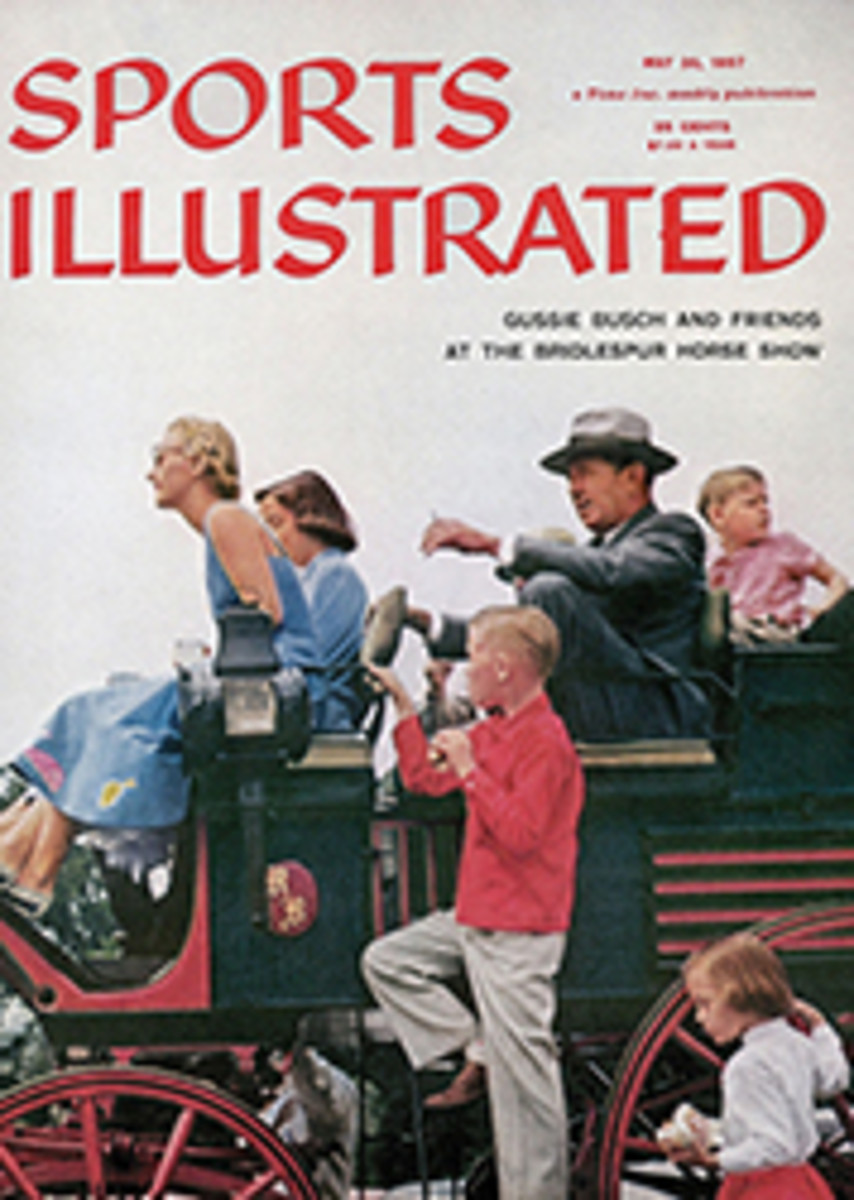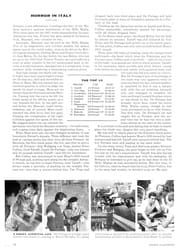
BOATS UNLIMITED
If there is one common denominator in the complex industrial society of Detroit, it is pleasure boating. From Playboy Horace Dodge, who spent millions out of his family auto fortune trying to win speedboat trophies, on down to the auto-plant sweeper who pays $5 to join an outboard club, the people of Detroit spend their spare time on the water. And, as the pictures on these pages show, the Detroit yachtsman, aided by handy docking facilities like the 225-berth City Basin at right and abetted by the racing committees of half a dozen yacht clubs, sometimes goes about his boating in a way that must be seen to be believed.
No Detroit sailor worth his salt, for example, would hesitate to joust with a mammoth lake freighter (see page 18) to get a clear shot at the starting line in an important race. Nor would the driver of a roaring hydroplane think twice about slamming through a rival's wake at 150 mph if such derring-do could help take the Gold Cup out of Seattle, home of the enemies of Detroit's unlimited racing class.
To an out-of-towner, used to thinking of Detroit in terms of assembly lines and new grillwork, all this water-borne excitement might seem a little out of place. But native Detroiters, reared by the edge of the maritime funnel formed by Lake St. Clair and the Detroit River, consider it the most natural thing in the world. For the fact is that Detroit's marine history is as old as the city itself; and in this motor-minded town pleasure boating grew up right along with the automobile. Back in the winter of 1903, a Detroit man named Cameron Beach Waterman turned out the first production outboard motor in the U.S. At about the same time a ship's carpenter named Christopher Columbus Smith began building Chris-Crafts in an auto-style assembly plant, the first boatbuilder to try production-line methods. Along this same strip of water another Detroiter, Gar Wood, dominated international speedboat racing as no other man has before or since. Nine times in the years between 1920 and 1933, Wood's boats won the Harmsworth Trophy. And at the end of the 1933 season, when he announced the retirement of the 48-cylinder, 7,600-hp Miss America X, the sport of speedboat racing—in fact, motorboating in general—had climbed from the hobby of back-bay tinkerers to a major national pastime.
The city is justifiably proud of its boating heritage. But unlike a lot of other towns that got there first with something and then quit, Detroit is still around today with the most in boating. The Detroit Yacht Club, for instance, with its 3,300 members and 384 berths is the biggest yacht club in the world. Its membership reads like a Who's Who of engineering. Chris Smith and Gar Wood were DYC members. So was old Henry Ford. So is Benson Ford. So are Charles F. Kettering, Charles Sorensen and a long list of other industrial tycoons.
Not far from the Detroit Yacht Club is another maritime society of some 1,300 members, the ancient and honored Detroit Boating Club. In terms of history, it claims to be the oldest (est. 1839) boating club in the U.S., having survived, as its conservative membership points out, a succession of catastrophes, including several major fires and 11 Democratic administrations. In terms of today, the boat club fosters one of the most active rowing programs in the country. Early every morning a hundred dedicated oarsmen, among them two crews that rowed for the U.S. at Melbourne last fall, pull off for hour-long workouts in their slim, varnished shells.
Then there is the Grosse Pointe Yacht Club, with its glass-walled swimming pool, dazzling debutante parties and expensive Chris-Crafts—the most glamorous of Detroit's yacht clubs. And the Little Club, a quiet collection of some 275 members that steadfastly declines to reveal its membership list, its dues or initiation fees, saying only that it has "Detroit's oldest families." And, finally, the club that claims to be the most serious sailing club of all, the Bayview Yacht Club.
About the Bayview membership, Commodore Lynn Stedman Jr. explains, "There are no social fences here. A man must show sailing skill to belong." As for the clubhouse itself and the physical surroundings, no one even bothers to explain. Bayview is located near an industrial wasteland behind the Detroit Edison Co. power plant; the peripheral area looks like Tobacco Road. However, the Bayview membership couldn't care less. They come down to work on their boats, and to race in such classics as the Port Huron-Mackinac or the Chicago-Mackinac, the biggest and the longest of all fresh-water sailboat races.
It should not be inferred from any of the above that Detroit, after starting out 54 years ago with the outboard, has given itself over to sailing. Quite the reverse. For, while the sailors may have more time and perhaps more money, it is the outboarders who have more boats—60,000 the last time anyone around the city tried to count the kickers.
Perhaps 150 of these are racers, auto workers who take a busman's holiday every night of their lives when they leave the mammoth assembly lines to come home and tinker with their engines. They may belong to clubs like the Belle Isle Stock Outboard Club, and indirectly to the American Power Boat Association, from whose Detroit offices come the sanctions for most U.S. speedboat races.
But the other 59,850 are fishermen and family cruising fans, who belong to nothing but the great fraternity of American boatmen. Each week thousands of them run downriver to Fighting Island or Grosse Isle, where the fishing is good, or portage by boat trailer to the fine lakes in the Pontiac or the Belleville-Ypsilanti areas. Their bigger inboard brothers stay closer to home, berthing their boats in the canals between Nine Mile and Ten Mile roads. And any skipper who runs short of supplies can stock up at Kean's 22-acre Detroit Yacht Harbor, which has what it calls the nation's only real marine supermarket. "You can come in here," says Louie Kean, "and get boating supplies, furniture, clothing, groceries, hardware and whisky. We've got 18,000 items—including chrome-plated screws, which we might not sell until next year. But we've got them if anybody asks."
Put them all together, the industrialists with their glittering cruisers, the hydro men with their hatred of Seattle, the outboarders with their trailers and the sailors with their pretty sloops and yawls, and you get one of the most startling scenes of marine activity anywhere in the world. No one really knows how many pleasure boats there are in Detroit, although everyone agrees the number is at least 100,000. Perhaps the most honest estimates have come, variously, from an awestruck reporter ("That's a hell of a lot of boats"), and from the local Coast Guard ("We have a very congested situation"). So congested, in fact, that last year a city judge began handing out speeding fines to marine hot rodders. Hardly anyone minds the congestion, though. For a water traffic jam on Sunday is getting to be a city institution. Besides, in a town like Detroit, with a boat for every seven families, the point is to get out on the water yourself, not worry about keeping other people home.
PHOTO
DAVID KITZ
DRIVER'S VIEW from cockpit of Canada's racing hydroplane Miss Supertest II shows Detroit Pilot Danny Foster blazing through a speed run against George Simon's Miss U.S. on practice course on Detroit River.
PHOTO
DAVID KITZ
City Boat Basin, carved out of waterfront next to swank River House (right), offers mooring for 225 craft.
PHOTO
DAVID KITZ
With Sheraton-Cadillac Hotel (left rear), the Industrial Building (center skyline) and the Ford Building (second from right) forming massive backdrop, John R. Miller's blue-hulled sloop "Valiant" slides clear of rival yachts before start of Riverama
TWO PHOTOS
DAVID KITZ
Fifty-four-foot ketch "Resolute" (above), manned by Grosse Pointe Sea Scouts, heads out of Detroit River into Lake St. Clair for an afternoon sail. Below, pretty Elaine Milke acts out charade during pirate party put on by Detroit Coast Guard Auxiliary on Gull Island in lake
PHOTO
DAVID KITZ
GRACEFUL CHRIS-CRAFT Gypsy, owned by Edward C. Quinn, president of the Chrysler Division of the Chrysler Motor Corporation, heads out for day-long cruise on Lake St. Clair.
PHOTO
DAVID KITZ
OUTBOARD TRAILERS jammed into parking lot at foot of Fairview Street near launching ramp on Detroit River show new trend to mobile boat berths among city's 60,000 outboarders.
PHOTO
DAVID KITZ
RACING SLOOP Revelry, owned by Norman (Nubby) Sarns of Mt. Clemens, Mich., won fleet honors in 1955 Chicago-Mackinac race, took Class B title in last season's 235-mile Port Huron event.

